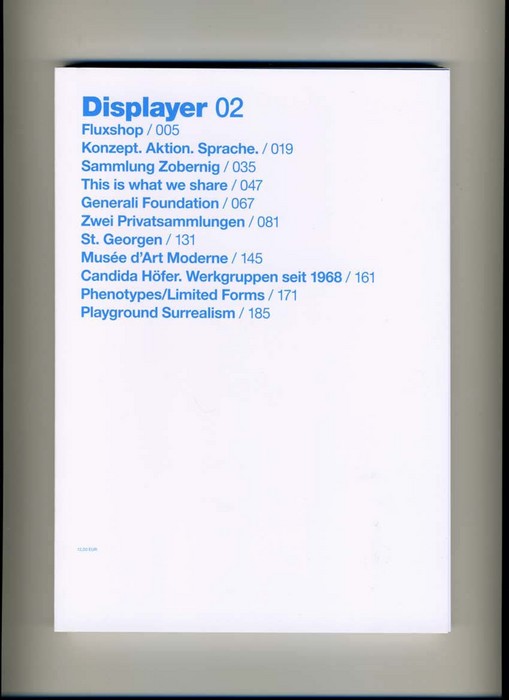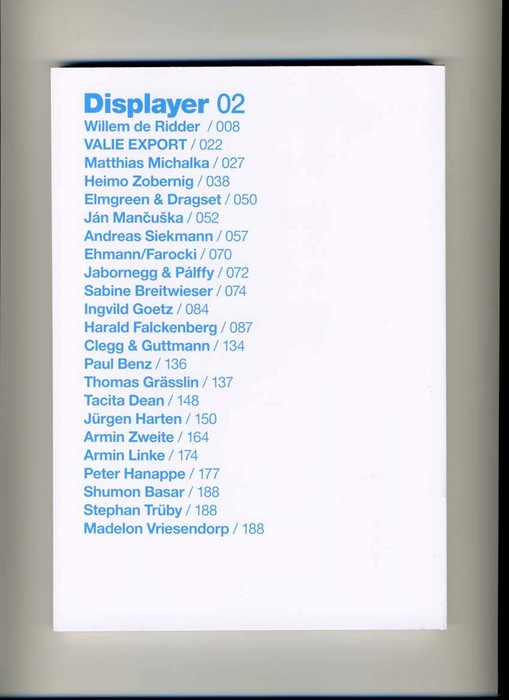DISPLAYER 02

Displayer 02 is published by the programme Exhibition Design and Curatorial Practice at University of Arts and Design Karlsruhe.

The second volume in the Displayer series offers original texts by artists, curators, architects, collectors, computer specialists, and a museum administrator. The individual contributions bring together kaleidoscopically an investigation concerned with part of the exhibition process that precedes the presentation proper: the specific selection of exhibits and making them visible in space. The more specific a presentation proposal is, the more precise will be the criteria for selecting the works. Numerous, sometimes heterogeneous factors and interests influence individual and scholarly selection criteria at various times. Curators and exhibition architects are involved in these processes as are art collectors and the artists themselves. The site of the presentation is particularly important here as well: both the architectural circumstances of the space and institutional categories crucially influence the decisions and ultimately the public visibility.
Every exhibition represents a temporary collection. A collection is not, however, solely the result of the accumulation of objects but also of their exclusion. It can never be complete as otherwise it would lose its qualities of development and change, or, as the title of a publication on the history of collection would have it: Macrocosmos in Microcosmo (ed. Andreas Grote, Opladen 1994). Like that of an exhibition, the program for a collection can scarcely follow principles for ordering facts such as size, date, technique, or medium. On the contrary, in an exhibition the selection of exhibits is presented in such a way that new contexts and interpretations of the subject matter can be read out of it. They can follow a scholarly mission, on the one hand, and focus on the subjectivity of the curator or collector, on the other. Through its presentation in the space, its selective gaze takes on a manifestation tied to a specific place and time that obeys its own logic. Consequently, the viewer’s path through the exhibition is based on these specific optical qualities, and site-specific components such as routes, axes of sight, and lighting situations govern both the viewer’s gaze and movements in the space.
Every exhibition is at the same time an instrument for publishing. The presentation of a collection as an exhibition in space publishes the selective gaze. Displayer 01 examined various projects and artistic positions in order to explore the activation of spaces by means of the exhibition architecture in conjunction with the curatorial concept: the etymological roots of ’display’ lie in the Latin word ’displicare’, which means ’unfold,’ ’lay open,’ ’spread out.’ If we pursue the principle of spreading out further, the exhibition design possesses the potential of a publishing vocabulary that shapes a spatial form in order to address the public. Like the graphic design of a publication, the curatorial design for an exhibition creates order within the information selected and at the same time offers a mechanism for seeing and remembering. The ordering in space not only guides the viewer’s gaze but also enables the memory to call up the specific optical qualities and selection later. These strategies of making visible lead to a politics of visibility: How is something shown? How does one remember? What does that mean for the presentation of a collection? If both the presentation of a collection and memory have their own forms of conservation—such as archiving, producing a catalog, reporting—then we also have to inquire into processes of historical writing. It is only with public access to a collection that procedures such as multiple viewing and critical documentation become possible.
Displayer 02 explores in eleven chapters various collecting strategies in connection with their presentation concepts. The points of departure for these examinations are private and institutional art collections as well as artistic practices. The objective of the publication is to distinguish more precisely between various typologies of collection. As in the first volume of the Displayer series, the second one also puts questions to the protagonists, though this, time the thematic focus has changed. Fluxshop and Concept. Action. Language. are new presentations of the collection of MUMOK in Vienna; those chapters examine the difficult tension between artistic works, which exist in the historical moment or outside of the museum and their presentation in the museum which aims at time-lessness. Zobernig Collection brings together the critical points of the art institution that are employed for the production of visibility and publicness. Andreas Siekmann, Ján Mancuška, and Elmgreen & Dragset argue using various terms such as ’division into zones,’ ’time,’ and ’specifications’ about what we share with one another in an exhibition: the space. The theme of private collections is examined in greater detail in the chapters on the Generali Foundation, Two private collections, and St. Georgen; themes such as the location of the collection, image, transfer, conflicts of interest, and subjectivity are the focus. With his invention of the Musée d’Art Moderne, Marcel Broodthaers exposed not only the absurdity of selection criteria (in this case, the motif of the eagle) and strategies for presentation in a museum; in the process he influenced a series of generations of artists. What would an update of it look like today? The photographic gaze is also subject to a specific optical quality. In very different ways, the chapters on Candida Höfer and Phenotypes /Limited Forms thematize photography as an instrument of collecting: first, the collecting of spaces in Höfer’s work; second, the creation of a personal collection in the form of Linke’s archive of photographs, which makes up the color section of the present volume. In the souvenir and object collection of the artist Madelon Vriesendorp, who is known above all for her drawings in collaboration with architects such as Rem Koolhaas and Charles Jencks, other aspects come to the fore: What relationships of scale are we confronted with when a selective gaze at the world is spread out as a collection of objects in an architectonically defined space?
Foreword Displayer 02, Doreen Mende.
Displayer 02 is the second issue of a publication series and published by Wilfried Kuehn and the programme Exhibition Design and Curatorial Practice at University of Arts and Design Karlsruhe.
Chief Editor: Doreen Mende
Editorial Team: Samuel Korn (Editorial Assistant), Alice Wilke (Editorial Assistant), Katharina Domokosch, Felicity Grobien, Johanna Hoth, David Howoldt, Sophie Remig, Felix Vogel, Sarah Waldschmitt.
Contributors of Displayer 02: Willem de Ridder, VALIE EXPORT, Matthias Michalka, Heimo Zobernig, Elmgreen & Dragset, Jan Mancuska, Andreas Siekmann, Ehmann/Farocki, Jabornegg&Palffy, Sabine Breitwieser, Ingvild Goetz, Harald Falckenberg, Clegg & Guttmann, Paul Benz, Thomas Grässlin, Tacita Dean, Jürgen Harten, Armin Zweite, Armin Linke, Peter Hanappe, Shumon Basar, Stephan Trüby, Madelon Vriesendorp.
200 pages with a photographic sequence by Armin Linke and various b/w images.
www.displayer-hfg.de
